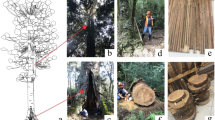Abstract
Many trees sprout after cutting and other disturbances, and individuals may persist for a long time. In 25 forests in Sweden subjected to thinning for biodiversity values, we tested whether survival and growth of sprouts are related to stump diameter. Stem diameters vary under conservation thinning and earlier work had indicated high survival of stumps of small diameter. We also tested whether a continuum of responses in sprouting existed among the 14 species, as predicted by earlier work. We cut on average 26 % of the basal area (mean basal area 28 m2/ha) and analysed 1,044 stumps (diameters 10–76 cm). The response of the species after 9 years ranged along a continuum from weak to strong sprouting. Survival was highest for Corylus avellena (95 % of cut individuals survived) and Tilia cordata (85 %), then decreased as follows; Crataegus spp. > Alnus glutinosa > Prunus avium > Fraxinus excelsior > Quercus robur/Q. petraea > Salix caprea > Sorbus aucuparia > Acer platanoides > Betula pendula, to Betula pubescens (8 %) and Fagus sylvatica (8 %). Within species, stump survival was unrelated to stump diameter. Mean maximal sprout height of surviving stumps varied from about 1 to 4 m among the species after 9 years. Sprout height was unrelated to stump diameter. Stump survival (%) and mean sprout height were positively correlated across species. In conclusion, stem diameter had no effect on sprouting, but the 14 species could be clearly ranked in regrowth. Our results are useful in planning thinning of mixed forests for biodiversity conservation, for biomass harvest, or combined purposes.





Similar content being viewed by others
References
Albert K, Annighöfer P, Schumacher J, Ammer C (2014) Biomass equations for seven different tree species growing in coppice-with-standards forests in Central Germany. Scand J For Res 29:210–221
Bauhus J, Puettman K, Messier C (2009) Silviculture for old-growth attributes. For Ecol Manage 258:525–537
Bellingham PJ, Sparrow AD (2000) Resprouting as a life history strategy in woody plant communities. Oikos 89:409–416
Bond WJ, Midgley JJ (2001) Ecology of sprouting in woody plants: the persistence niche. Trends Ecol Evol 16:45–51
Brudvig LA, Blunck HM, Asbjornsen H, Mateos-Remigio VS, Wagner SA, Randall JA (2011) Influences of woody encroachment and restoration thinning on overstory savanna oak tree growth rates. For Ecol Manage 262:1409–1416
Del Tredici P (2001) Sprouting in temperate trees: a morphological and ecological review. Bot Rev 67:121–140
Dietze MC, Clark JS (2008) Changing the gap dynamics paradigm: vegetative regeneration control on forest response to disturbance. Ecol Monogr 78:331–347
Dwyer JM, Fensham R, Buckley YM (2010) Restoration thinning accelerates structural development and carbon sequestration in an endangered Australian ecosystem. J Appl Ecol 47:681–691
Enderle R, Peters F, Nakou A, Metzler B (2013) Temporal development of ash dieback symptoms and spatial distribution of collar rots in a provenance trial of Fraxinus excelsior. Eur J For Res 132:865–876
Götmark F (2007) Careful partial harvesting in conservation stands and retention of large oaks favour oak regeneration. Biol Conserv 140:349–358
Götmark F (2009) Experiments for alternative management of forest reserves: effects of partial cutting on stem growth and mortality of large oaks (Quercus robur/Q. petraea). Can J For Res 39:1322–1330
Götmark F (2013) Habitat management alternatives for conservation forests in the temperate zone: review, synthesis, and implications. For Ecol Manage 306:292–307
Götmark F, Berglund Å, Wiklander K (2005) Browsing damage on broadleaved trees in semi-natural temperate forest in Sweden, with a focus on oak regeneration. Scand J For Res 20:223–234
Gronewold CA, D’Amato AW, Palik BJ (2010) The influence of cutting cycle and stocking level on the structure and composition of managed old-growth northern hardwoods. For Ecol Manage 259:1151–1160
Harrington CA (1984) Factors influencing initial sprouting of red alder. Can J For Res 14:357–361
IBM (2011) IBM SPSS statistics, release 20.0.0 of software, www.ibm.com
Johansson T (2008) Sprouting ability and biomass production of downy and silver birch stumps of different diameters. Biomass Bioenergy 32:944–951
Johnson PS, Shifley SR, Rogers R (2002) The ecology and silviculture of oaks. CABI, Wallingford
Jonsell M (2012) Old park trees as habitat for saproxylic beetle species. Biodiv Conserv 21:619–642
Joys AC, Fuller RJ, Dolman PM (2004) Influences of deer browsing, coppice history, and standard trees on the growth and development of vegetation structure in coppiced woods in lowland England. For Ecol Manage 202:23–37
Kardell L, Fiskesjö A-L (1999) Vessers udde 1921–1992. Skog, vegetation och mark efter 70 års fridlysning. Rapport 83, Inst. för skoglig landskapsvård, SLU Uppsala, 126 pp (in Swedish)
Keeton WS (2006) Managing for late-successional/old-growth characteristics in northern hardwood-conifer forests. For Ecol Manage 235:129–142
Kennedy CEJ, Southwood TRE (1984) The number of species of insects associated with British tress: a re-analysis. J Anim Ecol 53:455–478
Koorem K, Moora M (2010) Positive association between understory species richness and a dominant shrub species (Corylus avellana) in a boreonemoral spruce forest. For Ecol Manage 260:1407–1413
Luostarinen K, Kauppi A (2005) Effects of coppicing on the root and stump carbohydrate dynamics in birches. New For 29:289–303
Mallik AU, Bell FW, Gong Y (1997) Regeneration behavior of competing plants after clear cutting: implications for vegetation management. For Ecol Manage 95:1–10
Månsson J, Kalen C, Kjellander P, Andrén H, Smith H (2007) Quantitative estimates of tree species selectivity by moose (Alces alces) in a forest landscape. Scand J For Res 22:407–414
Matula R, Svatek M, Kurova J, Uradnicek L, Kadavy J, Kneifl M (2012) The sprouting ability of the main tree species in Central European coppices: implications for coppice restoration. Eur J For Res 131:1501–1511
McGee GG, Leopold DJ, Nyland RD (1999) Structural characteristics of old-growth, maturing, and partially cut northern hardwood forests. Ecol Appl 9:1316–1329
Neill AR, Puettmann KJ (2013) Managing for adaptive capacity: thinning improves food availability for wildlife and insect pollinators under climate change conditions. Can J For Res 43:428–440
Nordén B, Götmark F, Ryberg M, Paltto H, Allmer J (2008) Partial cutting reduces species richness of fungi on woody debris. Can J For Res 38:1807–1816
Nordén B, Paltto H, Claesson C, Götmark F (2012) Partial cutting can enhance epiphyte conservation in temperate oak-rich forests. For Ecol Manage 270:35–44
Pelc BD, Montgomery RA, Reich PB (2011) Frequency and timing of stem removal influence Corylus americana resprout vigor in oak savanna. For Ecol Manage 261:136–142
Pigott CD (1991) Tilia cordata Miller. J Ecol 79:1147–1207
Pykälä J (2000) Mitigating human effects on European biodiversity through traditional animal husbandry. Conserv Biol 14:705–712
Pyttel PL, Fischer UF, Suchomel C, Gärtner SM, Bauhus J (2013) The effect of harvesting on stump mortality and re-sprouting in aged oak coppice forests. Forest Ecol Manage 289:18–27
R Development Core Team (2010) R: a language and environment for statistical computing. R Foundation for Statistical Computing, Vienna
Rackham O (1998) Implications of historical ecology for conservation. In: Sutherland WJ (ed) Conservation science and action. Blackwell Science Ltd, UK, pp 152–174
Sakai A, Sakai S (1998) A test for the resource remobilization hypothesis: tree sprouting using carbohydrates from above-ground parts. Ann Bot 82:213–216
Shure DJ, Phillips DL, Bostick PE (2006) Gap size and succession in cutover southern Appalachian forests: an 18 year study of vegetation dynamics. Plant Ecol 185:299–318
Singer MT, Lorimer CG (1997) Crown release as a potential old-growth restoration approach in northern hardwoods. Can J For Res 27:1222–1232
Sitzia T, Semenzato P, Trentanovi G (2010) Natural reforestation is changing spatial patterns of rural mountain and hill landscapes: a global overview. For Ecol Manage 259:1354–1362
Splichalova M, Adamec Z, Kadavy J, Kneifl M (2012) Probability model of sessile oak (Quercus petraea (Matt.) Liebl.) stump sprouting in the Czech Republic. Eur J For Res 131:1611–1618
Stanturf JA, Madsen P (eds) (2005) Restoration of boreal and temperate forests. CRC Press, Boca Raton
Szabo P, Hedl R (2013) Socio-economic demands, ecological conditions and the power of tradition: past woodland management decisions in a central European landscape. Landsc Res 38:243–261
Szymura TH, Buszczak M, Szymura M (2010) Structure and dynamics of a mature tree stand in submontane alluvial forest of Carici ramotae-Fraxinetum in the Sudety Mts foothills (Lower Silesia, Poland). Dendrobiology 63:43–51
Timonen J et al (2010) Woodland key habitats in northern Europe: concepts, inventory and protection. Scand J For Res 25:309–324
Vesk PA, Westoby M (2004) Sprouting ability across diverse disturbances and vegetation types worldwide. J Ecol 92:310–320
Wam HK, Hjeljord O (2010) Moose summer and winter diets along a large scale gradient of forage availability in southern Norway. Eur J Wildl Res 56:745–755
Weigel DR, Peng CYJ (2002) Predicting stump sprouting and competitive success of five oak species in southern Indiana. Can J For Res 32:703–712
Acknowledgments
The Swedish Energy Agency and the University of Gothenburg provided funding. We thank the following forest owners and managers for support and help: Sven-Gunnar and Dan Ekblad; Anders Heidesjö; Göte, Gullan and Mikael Isaksson; Anette Karlsson; Bo Karlsson; Nils-Olof and Jan-Åke Lennartsson; County Administrations of Kalmar and Östergötland; municipalities of Borås, Jönköping, Oskarshamn and Växjö; dioceses of Linköping and Skara; and the companies Boxholms Skogar, Holmen Skog and Sveaskog. We thank Radim Matula, Magnus Löf, and anonymous reviewers for comments on the manuscript, Elin Götmark for corrections of the English, and Linn Bergström, Christina Claesson, Henning Gustavsson, Tuvis Lager, Sofia Pallander, Sanna Sundvall, Max Wikström, and Linn Zetterström for field assistence.
Author information
Authors and Affiliations
Corresponding author
Additional information
Communicated by Christian Ammer.
Electronic supplementary material
Below is the link to the electronic supplementary material.
Rights and permissions
About this article
Cite this article
Leonardsson, J., Götmark, F. Differential survival and growth of stumps in 14 woody species after conservation thinning in mixed oak-rich temperate forests. Eur J Forest Res 134, 199–209 (2015). https://doi.org/10.1007/s10342-014-0843-1
Received:
Revised:
Accepted:
Published:
Issue Date:
DOI: https://doi.org/10.1007/s10342-014-0843-1




